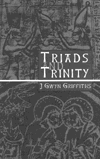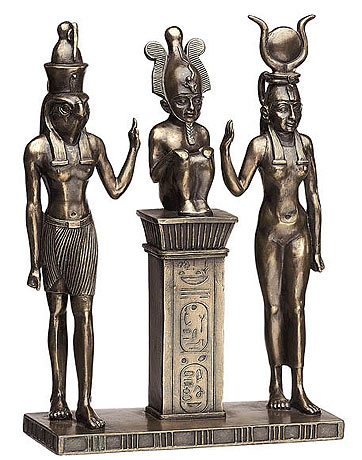In 2007 I read Triads and Trinity, by the late Classicist and Egyptologist John Gwyn Griffiths, a book which tries to trace outside influences on the development of the Christian doctrine of the Trinity. I was skeptical about any such project, as I knew it has long been a staple of crackpot antitrinitarians to allege that the Trinity doctrine was illegally imported from (take your pick) Babylon, Neoplatonism, Hinduism, etc. This book, however, seemed legit. Here’s the publisher’s description:
Was the idea of the Trinity-that One God exists in Three Persons and One Substance – influenced by pre-Christian traditions? It is well known that the New Testament offers no such doctrine, and there is no evidence that Jesus of Nazareth regarded himself as a member of the Trinity. The doctrine was developed during the first four Christian centuries, culminating in the Council of Constantinople in AD 381. The world of the early Christian centuries in which the Trinity was developed as a tenet of belief included several religious and philosophical systems with similar beliefs. Triads and Trinity examines three possible areas of impact: Judaism, the religion of Egypt, and various Greek traditions. Whereas a pluralistic concept of God was inherited by Judaism, it eventually accepted a firm monotheism. In Egypt the concept of trinity was of ancient origin, but it flourished especially in the second century AD and afterwards, when the mystery cult of Isis reached its acme of popularity in a Graeco-Egyptian framework which found adherents in many countries of the Roman empire. This Graeco-Egyptian religious amalgam exercised a potent influence on early Christian thinkers, particularly in Alexandria. Using the methods of comparative religion, the distinguished Classicist and Egyptologist J. Gwyn Griffiths has examined the origins of the doctrine of the Trinity and has based his conclusions on a thorough analysis of the original sources in Greek, Latin, Egyptian, Coptic and Hebrew. (From here.)
Now that I’ve slogged through read it, I thought I’d post a mini-review.
First, this is not a book of philosophy or theology. It is in the genre of comparative religion. The brush-strokes are often broad, and the history of doctrine and metaphysical aspects will not satisfy specialists in, say, early Christian doctrine, the early Fathers, or philosophical theology. Sometimes the author’s opinions in these areas are quite informed and plausible, and sometimes they are less so.
Second, the book is poorly organized. The author’s real thesis is only clear by the end of the book, and topics of discussion jump around, with truckloads of historical details being frequently dumped on the reader. Much of the book consists in quick summaries and comments on previous studies on the topics in question. This is good and bad. It is a resource for the serious student, but a hard read for everyone else.
What Griffiths is up to is this. He’s looking for influences on the formation of trinitarian doctrine, but he doesn’t go looking for “trinities” (three persons in one substance) – because he knows he won’t find precisely that outside Christianity, but he rather collects and examines “triads”.
When three deities are grouped together in art or in literature frequently enough to suggest that they are regarded as forming an established group, for our puposes they constitute a triad. (3)
Fair enough. And out come a boatload of them, from the religions of early and late Egypt, Mesopotamia, India, Iran, Greece, Rome, the Celts, China, and miscellaneous northern European tribes. And then we have examples from Judaism, Gnosticism, and Neoplatonism. Frustratingly, after trotting out most of these, he admits that most of them are too far in time and/or place to plausibly be regarded as an important influences on the development of the doctrine of the Trinity. He thus focuses on Judaism, Greek philosophy and religion, and late Egyptian religion.
Unlike the crackpots, Griffiths is aware that just because you find something earlier than a piece of Christian art or doctrine that resembles it, it doesn’t follow that there is any causal connection between them. In the end, he thinks there were important outside influences on the doctrine, but as we’ll see, this claim is so qualified, that it’s not clear what the interest of it is, even if it’s true.
One idea in the book, which I simply don’t grasp, is that the matter or substance of the Trinity doctrine comes from the Bible, but the form or structure of it comes from somewhere else. Apparently this idea is current else where in the looking-for-antecedents-of-the-Trinity literature. All I can guess is, this is a way of maintaining peace with orthodox Christianity – congratulating them from having a doctrine truly based on the Bible in a sense, but which in another sense came from elsewhere.
Warning: spoilers ahead! Here are his conclusions.
Structurally the heritage of Israel and Judaism prepared Christian minds for the idea that unity and plurality could characterize the divine, even if the idea was not as a rule on specifically triadic lines. …But for the highly distinctive idea of tri-unity we must turn to Egypt, where the New-Kingdom theology began to treat the triad as a trinity. In the early Christian centuries this development was endorsed by Greek influence: the Platonic triadic systems sometimes came close to the dimension of trinitarianism, and popular Greek syncretism was often ready to regard three deities as one. (306-7)
As an Egyptologist, it’s not surprising that he thinks Egyptian religion has historically been shorted when it comes to its influence on Christian doctrine. But I’m not clear on how he really connects the two. He only shows that certain church fathers, particularly in Alexandria, knew about various Egyptian cults. One would think that it’d be the Neoplatonism’s “three hypostases” who were in some sense all “the One” but not that’d get the main credit, seeing as how the Cappadocians were all steeped in Neoplatonism, and they by all accounts played a crucial role in the development of the doctrine in the fourth century. (See particularly Hanson’s Search, 863-9.) He repeatedly dismisses their relevance, though, on the grounds that Platonic threesomes were mere “abstractions”. Go figure.
In sum, I recommend this book only to specialists, mainly those interested in the details of threesomes in the religions of the near East, who also want to compare these to early Christian trinitarian thought. To those interested in the truth of or evidence for the Christian doctrine(s) of the Trinity, this book is of little relevance. So what if there was this influence? Maybe these other religions and philosophies were God’s ordained vehicle to “make straight the way” for the Cappadocians (or whoever) to finally (take your pick) draw out the implications of the Bible for the metaphysics of God or expand on the contents of the Bible, by the guidance of the Holy Spirit, creating a new but true doctrine. Note that no one defends their belief in the Trinity by appealing to Egyptian religion or the doctrines of Greek philosophy. There are rather arguments from the Bible, from the authority of the church and the orthodox tradition, and from reason (i.e. a priori arguments for social trinitarianism). Friends and enemies of trinitarianism will have to engage on those fields, not on the field of comparative religion. At the very most, if it could be shown that no trinity doctrine can be derived from the Bible, Griffith’s theories might provide a partial explanation of where it did come from. But origin is one issue, and truth is another.

